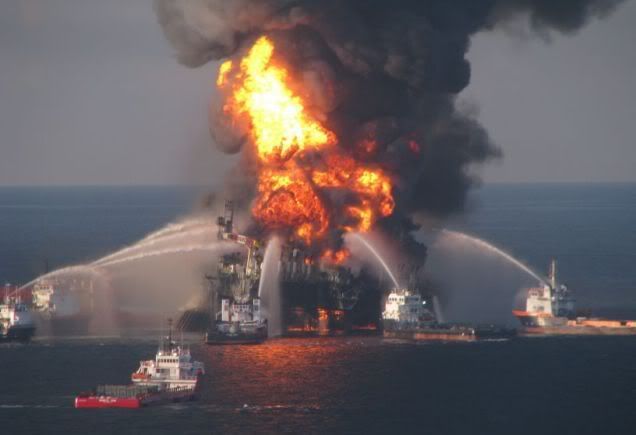
Well how the frack d'ya like me now?
I'm not going to say "toldya so", since many who will be reading this diary said much the same during the "Drill, Baby, Drill" absurdity in 2008 ... but the undersea oil volcano underlines, boldfaces and highlights in red the basic facts of the situation that we face:
- Our country produces about twice as much crude oil per person as the world average
- Our country consumes about five times as much crude oil per person as the world average
- And we have been producing oil a long time, have passed our peak of domestic oil production, and aint ever getting back to it.
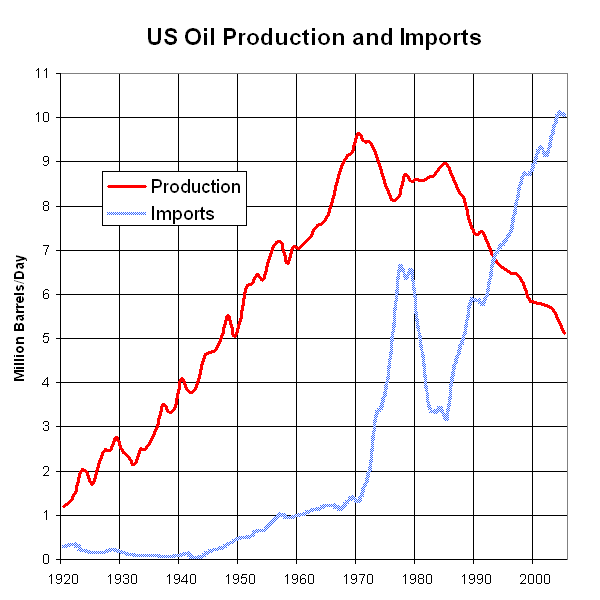 And, anyway, we already tried Drill, Baby, Drill. Its played itself out already.
And, anyway, we already tried Drill, Baby, Drill. Its played itself out already.Obviously, the direction to go to insulate ourselves from oil price shocks and the recessions they cause is to cut our consumption. Which means, in part, Train, Baby, Train.
So, what is it about trains, anyway?
I would admit that I have a big model train set in the basement - except its not mine, its my stepfather's. For me, trains are transport, a way to get from Point A to Point B. Indeed, the mode of transport that has a special place in my heart over and above their functional utility is not trains so much as bikes (and living in NE Ohio, I must hasten to explain "Bikes like Schwinn's are Bikes, not Bikes like Harley's are Bikes").
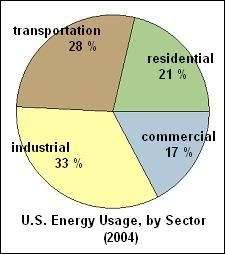
No, this is why trains. We consume 28% of our energy in the transportation sector. If we are going to reduce our oil consumption by 5% a year each year for the next 20 years, that means we have to consume the consumption of petroleum by transport by 5% a year, each year for the next 20 years.
We also have to get off mineral coal, but it turns out that trains can contribute to that as well.
My focus here, today, is how to use the process of breaking our oil addiction as a means of providing the jobs that our economy needs, and does not and will not otherwise have, over the next decade.
Of course, when we focus on oil, transport is even more important. To get more specific, according to the government numbers, transport consumes about 2/3 of our petroleum. We produce about 40% of our oil consumption, and even if we cut our oil consumption by 5% a year ... by the time we have cut 60% of our present oil consumption in 12 years time, we will be producing less oil than we are producing now.
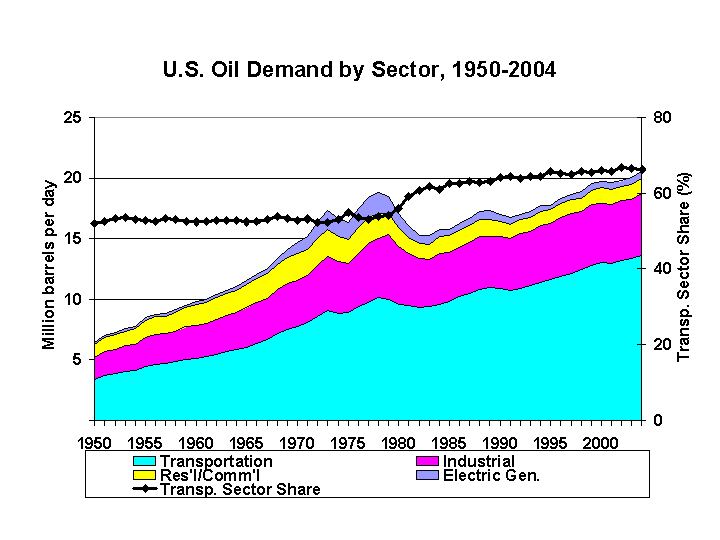
And once we get to the point where we are getting the majority of our transportation energy from sources other than oil, we can start looking to the future. One of the bright, glaring points about "Drill, Baby, Drill", why Drill, Baby, Drill represented the complete abandonment of Republican pretensions about being the grown ups in the room, is that when you pump out and burn oil, its just gone, never to come back.
After all the Republican pretensions I remember hearing ever since being a kid in the 60's and 70's about the Republicans being the party of "responsibility" - their approach to our non-renewable natural resources is "Burn It All As Fast As Possible and the Devil take the Hindmost!".
So, to cut our oil consumption by 5% a year over the decade ahead ... which will still leave us an oil importer, but take us off the front line for being the demand reduction via recession in future oil price shocks ... we need 7 of those 5% reductions to come from transport. And each and every one means more work over the coming decade.
I'll look at three of the seven, today.
1. The Steel Interstate

I described the Steel Interstate approach to Electrified, Rapid Freight Rail a couple of months ago, and then polished up the network map a bit the following week.
So, broad brush strokes here:
- 15,000miles+ of STRACNET corridors electrified with rail improvements that allow scheduled slots for 100mph Rapid Freight Rail
- Built primarily in existing freight rail rights of way by distinct government owned, not for profit "Line Development Banks"
- Those using the infrastructure pay Access and User fees that cover up-front capital costs
- Interest costs covered by a $0.01/gallon tax on imported petroleum, rising to $0.05/gallon over five years
This is based on the full scale plan offered by Alan Drake and studied by the Millenium Institute, and projected to be able cut our petroleum consumption by about 7%. And of course, the "first half" will result in more than half of that, provided it provides a rough grid that covers the bulk of the long-haul transport markets in the country ... so I'll slate this in as the first of the seven transport "5%/year" projects.
Note that the way I have sketched it out, the Access and User fees are ongoing, on a simple formula, and that a Line Development Bank has completed its line, it would be chartered to devote any capital surplus to the funding of energy-independence transport within its broader service area. So on the back of that funding, the Steel Interstate proposal is also one of the seven required 5% reductions in the second decade of our Freedom from Oil in Twenty Years program.
2. Local Electric Transport
Back in March of 2009, NBBooks wrote $3.195 trillion -TRILLION - for urban RAIL transit.
Where this is derived from is a target for rail transit density:
Building 50,757 kilometers of new rail transit lines, at a cost of $3.195 trillion. is based on building urban rail mass transit systems to the same service density found in New York City, in the next 38 largest urban areas. I began by assuming a desideratum of having a rail transit line no more than 2.5 miles from any point in an urban area. That is, if you took a square of urban area five miles on each side, we want to have a rail transit line running directly across the middle of that square. Slice that 25 square mile area into one mile strips, and you get one mile of rail transit line for every five square miles of urban area, or a density of 0.2 mile of rail transit line for every square mile. Converting square miles to square kilometers, and miles to kilometers, what we are looking for is a density of 0.124 mi {sic.=km} of rail transit line for every square kilometer of urban area.
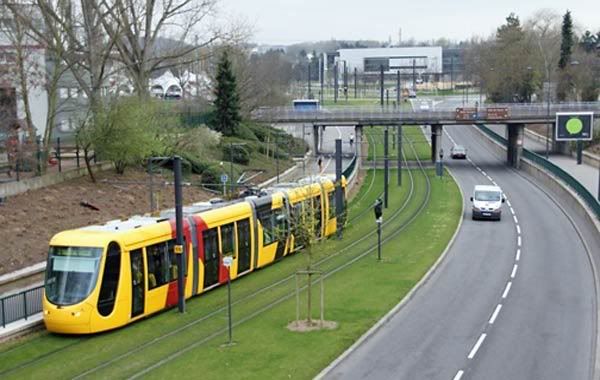 This is a fine density for densely populated areas, but I am of the view that moving to a sustainable settlement system from our current system that is dominated by sprawl-suburban settlement (in terms of representing half or more of all residential population, just as over half of the nation's residents at the previous turn of the century lived in urban rather than suburban areas) will require both rebuilding residential population in core urban areas and establishing urban density walkable neighborhoods along dedicated transport corridors running through suburban areas.
This is a fine density for densely populated areas, but I am of the view that moving to a sustainable settlement system from our current system that is dominated by sprawl-suburban settlement (in terms of representing half or more of all residential population, just as over half of the nation's residents at the previous turn of the century lived in urban rather than suburban areas) will require both rebuilding residential population in core urban areas and establishing urban density walkable neighborhoods along dedicated transport corridors running through suburban areas.This "clustered network city" approach of suburban transit villages connected to urban centers would seem to permit a looser rail network complemented by a mix of local transport access - by foot, bike, neighborhood electric vehicle, battery/trolleywire trolley bus, etc. So I ease this back to a rail transit line no more than 5 miles from any point in the urban area. That is then, above, a 10 mile square line with a line running down the middle, or a density of 0.1 miles of rail transit line for every square mile ... or 0.62 km line per sq. km.
However, taking the rest of NBBook's estimates, that is $1.6T (trillion with a T). Spread across ten years, $160b/year ... about 1% of our national economy.
How to finance that? Most directly, impose a 5% payroll levy on earned and unearned income received by those making over 7 times median income, roughly $280,000.
In order to achieve broad based oil independence, this would be allocated on a per capita basis to municipalities, counties and reservations, which they could annually allocate for construction or improvement of dedicated transport corridors and dedicated support facilities for electric common carrier transport. Since not all municipalities or counties cannot allocate their share, the annual surplus would be re-allocated to those able to invest their original share.
Is this a 5% piece? I think it likely will be, but I will have to look into that more closely. In any event, it is a piece that will be generating 3.75m jobs per year, every year for a decade.
3. Personal Transport
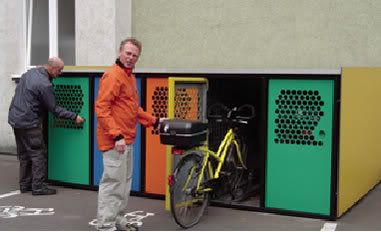
The third piece I would offer today is Personal, or "Active" Transport: Walking and Cycling.
The objection might be raised that this is not a rail project ... but in reality, it is the flip side of the local rail project above. A bike is a fine thing to ride for a couple of miles, but a ten mile ride is not a commute for a regular transport cyclist.
So the focus of increasing Active Transport sufficiently to save 5% of our petroleum imports is the establishment of a walkable zone around stops along the dedicated transport corridors, with a mandatory easement to allow three story, mixed used and stacked townhouse development within a quarter mile of the stop on the corridor.
Given the capital-efficiency of these modes of local transport, the funding can piggy-back onto the above system as well: for all funds drawn from the municipal, country and reservation accounts in support of dedicated transport corridors, 1% must be allocated to qualifying projects in support of Active Transport.
OK, so those are my three ...
... what are yours?
The Headliners: Midnight Oil with Truganini!
There's a road train going nowhere / roads are cut, lines are down ...

